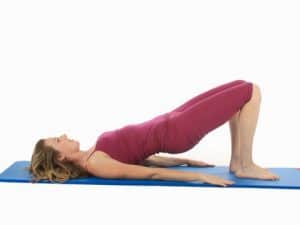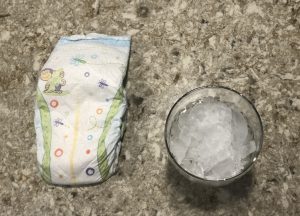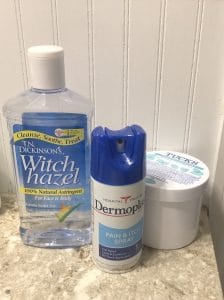
Jul 14, 2020 | Postpartum
Let’s Talk About It
The pelvic floor often gets ignored during regular checkups in postpartum, but are vital to our sexual and reproductive health. I talked about pelvic floor muscles during pregnancy in my previous blog post and now it’s time to talk about some of the nitty gritty details of pelvic health and postpartum. While our bodies expand and change in beautiful and often uncomfortable ways during pregnancy, they also go through A LOT during labor and birth. Our perineum has to stretch during vaginal birth and that, along with tearing, can have an impact on your pelvic floor health in postpartum and beyond.
Many new moms experience pelvic floor issues after vaginal birth and don’t seek treatment because women’s health is often stigmatized. So let’s talk about it! It’s the only way to push back and normalize the experiences of birthing people.
Once again, I reached out to Dr. Rachel Parrotta, DPT, for her take.
What’s Normal

Certain exercises like this bridge can help strengthen core and pelvic muscles
“The pelvic floor muscles undergo a very large stretch during vaginal birth and the pelvic region can be quite swollen in the first few weeks post-partum,” said Dr. Parrotta. “These factors can make it very challenging to coordinate your pelvic floor muscles (aka ‘Find your Kegel’) in the first few weeks after birth. Learning and practicing pelvic floor muscle coordination prior to birth can help develop ‘muscle memory’ that will assist you in postpartum recovery.”
I have oft heard phrases like “birth will wreck your vagina” said to new moms and it’s untrue. As Dr. Parrotta mentioned, the vagina and pelvic muscles largely expand. But, here’s the thing – they are meant to do this. After vaginal birth, your pelvic floor is bound to be swollen and aggravated. So, it’s completely normal to experience some postpartum incontinence and perineal discomfort in the following weeks.
What’s Not Normal
If you experience any of the following after you’re six-weeks pospartum, visit your care provider and seek out a pelvic health specialist:
- Pain during sex
- Perineal pain
- A heavy feeling or pressure in your perineal area
- Incontinence
- Difficulty urinating or passing a soft bowel movement
Final Thought
Your pelvic health is important. A healthy pelvic floor after postpartum can lead to better sexual satisfaction for you, more stability in your pelvic region, and better outcomes in future pregnancies.
Pelvic PT can be intimate, but it shouldn’t feel invasive. Find a practitioner you trust and get evaluated, because your health is worth it.

Jan 13, 2020 | Postpartum
You’ve done it! Congrats on your baby, mama! Be proud of what you’ve accomplished. Now it’s time for postpartum care.
Your care provider or childbirth educator may warn you about how you could feel after delivery. If you had a vaginal delivery, you’ll experience swelling around your vagina and perineum. Tearing is pretty common during birth, but there are varying degrees of severity. Third and fourth degree tears (the most severe) are less common, thankfully! And, I’m sorry to say, many of us will experience hemorrhoids from pushing. Every mama needs to take it easy to heal up.
I know this sounds scary. These discomforts, especially after being pregnant and uncomfortable, can be difficult. But you can get prepared for postpartum and what you’ll need to get through those first few weeks of healing.
Here are my top four postpartum care products for vaginal delivery.
1. Ice Diapers
 Hear me out – many maternity wards make these for new moms. Take a Pampers diaper and pull apart the top of the diaper. Fill it with ice chips. Then fold the open top and use the sticky tabs of the diaper to close. Watch directions here. This goes right in your underwear and IT WILL FEEL AMAZING.
Hear me out – many maternity wards make these for new moms. Take a Pampers diaper and pull apart the top of the diaper. Fill it with ice chips. Then fold the open top and use the sticky tabs of the diaper to close. Watch directions here. This goes right in your underwear and IT WILL FEEL AMAZING.
I had a second degree tear that was very close to being a third degree. Ice diapers were the only things that could completely numb my perineum and vagina. These were the most helpful in my postpartum care. The ice greatly helps reduce swelling after delivery. Another option if you don’t like the ice diaper is to make a padsicle – soak a maxi pad in witch hazel and stick it in the freezer for some nice cold pain relief.
 You may find a can of Dermoplast in your hospital room after delivery. It’s used to spray your perineum to cool and help numb any pain from swelling and hemorrhoids. The spray’s cooling effect provides some temporary relief. This was one of my go-tos after vaginal delivery.
You may find a can of Dermoplast in your hospital room after delivery. It’s used to spray your perineum to cool and help numb any pain from swelling and hemorrhoids. The spray’s cooling effect provides some temporary relief. This was one of my go-tos after vaginal delivery.
Another important product in my postpartum care kit for new moms is Tucks Pads. They are medicated with witch hazel to help relieve, you guessed it, hemorrhoids. But I found its cool temperature great for the perineum, as well. You can put them on your pad or panty liners.
4. Disposable Underwear
While I never saw myself wearing Depends until I reached ripe old age, using disposable underwear was the best advice I got from another mom. Women often bleed for several weeks after birth and may have trouble controlling pelvic muscles and actions, including peeing. A cough or sneeze, and like in pregnancy, a wee bit of wee may come out. I was so glad that I didn’t have to worry about my good underwear during postpartum. If I moved around too much one day and my bleeding got worse or I all of a sudden felt the urgent need to pee and wasn’t sure I’d make it to the bathroom, my disposable underwear had me covered.
Postpartum’s not glamorous for sure, but these items will definitely help get you recover from birth. If you want to learn more about what to expect from birth and postpartum, check out my Informed and Mindful Birthing online class.




 Hear me out – many maternity wards make these for new moms. Take a Pampers diaper and pull apart the top of the diaper. Fill it with ice chips. Then fold the open top and use the sticky tabs of the diaper to close.
Hear me out – many maternity wards make these for new moms. Take a Pampers diaper and pull apart the top of the diaper. Fill it with ice chips. Then fold the open top and use the sticky tabs of the diaper to close.  You may find a can of Dermoplast in your hospital room after delivery. It’s used to spray your perineum to cool and help numb any pain from swelling and hemorrhoids. The spray’s cooling effect provides some temporary relief. This was one of my go-tos after vaginal delivery.
You may find a can of Dermoplast in your hospital room after delivery. It’s used to spray your perineum to cool and help numb any pain from swelling and hemorrhoids. The spray’s cooling effect provides some temporary relief. This was one of my go-tos after vaginal delivery.
Recent Comments